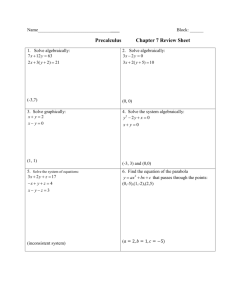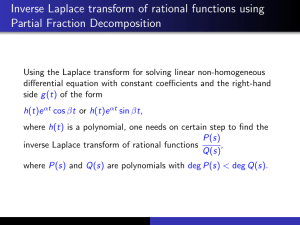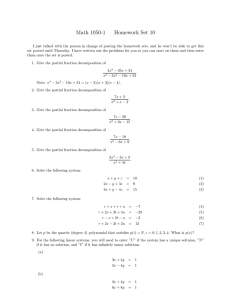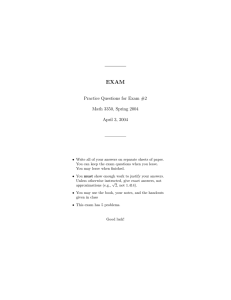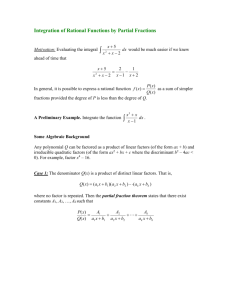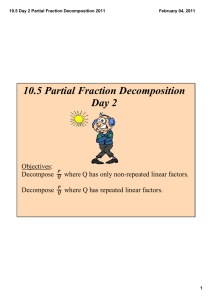Inverse Laplace transform of rational functions via
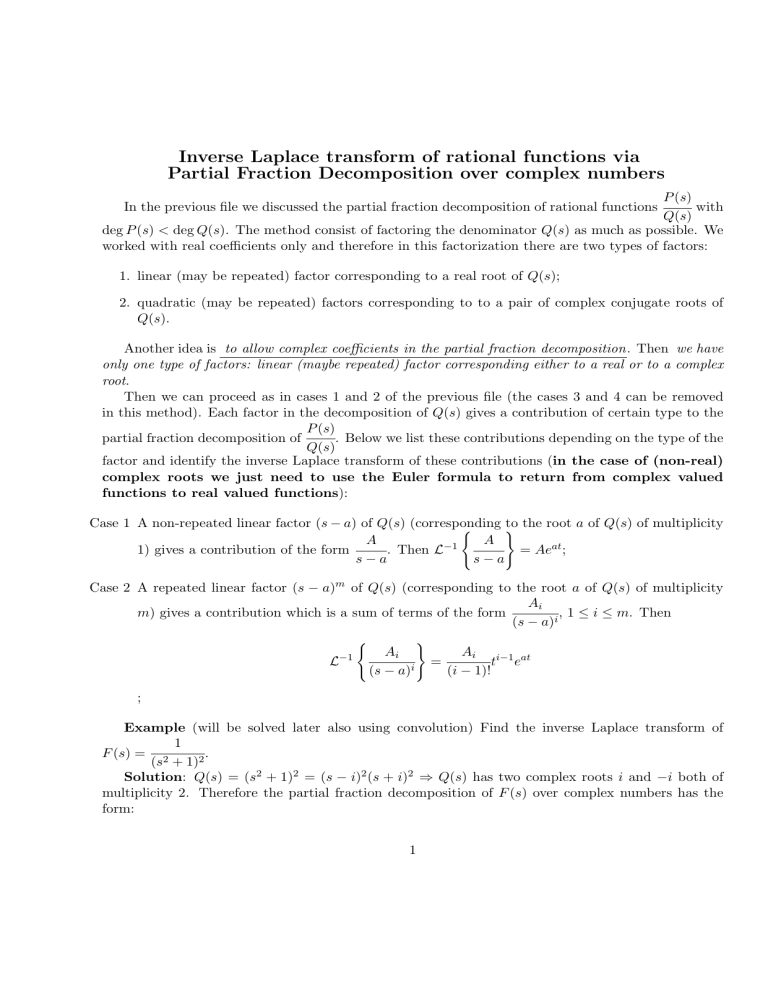
Inverse Laplace transform of rational functions via
Partial Fraction Decomposition over complex numbers
P ( s )
In the previous file we discussed the partial fraction decomposition of rational functions with
Q ( s ) deg P ( s ) < deg Q ( s ). The method consist of factoring the denominator Q ( s ) as much as possible. We worked with real coefficients only and therefore in this factorization there are two types of factors:
1. linear (may be repeated) factor corresponding to a real root of Q ( s );
2. quadratic (may be repeated) factors corresponding to to a pair of complex conjugate roots of
Q ( s ).
Another idea is to allow complex coefficients in the partial fraction decomposition . Then we have only one type of factors: linear (maybe repeated) factor corresponding either to a real or to a complex root .
Then we can proceed as in cases 1 and 2 of the previous file (the cases 3 and 4 can be removed in this method). Each factor in the decomposition of Q ( s ) gives a contribution of certain type to the partial fraction decomposition of
P ( s )
Q ( s )
. Below we list these contributions depending on the type of the factor and identify the inverse Laplace transform of these contributions ( in the case of (non-real) complex roots we just need to use the Euler formula to return from complex valued functions to real valued functions ):
Case 1 A non-repeated linear factor ( s − a ) of Q ( s ) (corresponding to the root a of Q ( s ) of multiplicity
1) gives a contribution of the form
A s − a
. Then L
− 1
( s
A
− a
)
= Ae at
;
Case 2 A repeated linear factor ( m s − a ) m of Q ( s ) (corresponding to the root a of Q ( s ) of multiplicity
) gives a contribution which is a sum of terms of the form
A i
( s − a ) i
, 1 ≤ i ≤ m . Then
L
− 1
(
A i
( s − a ) i
)
=
A i
( i − 1)!
t i − 1 e at
;
Example (will be solved later also using convolution) Find the inverse Laplace transform of
F ( s ) =
( s 2
1
+ 1)
Solution :
2
Q
.
( s ) = ( s
2
+ 1)
2
= ( s − i )
2
( s + i )
2 ⇒ Q ( s ) has two complex roots i and − i both of multiplicity 2. Therefore the partial fraction decomposition of F ( s ) over complex numbers has the form:
1
1
( s 2 + 1) 2
=
A s − i
+
B
( s − i ) 2
+
C s + i
+
D
( s + i ) 2
⇒
1 = A ( s − i )( s + i )
2
+ B ( s + i )
2
+ C ( s + i )( s − i )
2
+ D ( s − i )
2
= A ( s
2
+1)( s − i )+ B ( s + i )
2
+ C ( s
2
+1)( s + i )+ D ( s − i )
2
.
(1)
Determine A , B , C , and D :
1. Plug in s = i ⇒ 1 = B (2 i )
2
= − 4 B ⇒ B = −
1
4
;
2. Plug in s == i ⇒ 1 = D ( − 2 i )
2
= − 4 B ⇒ D = −
1
4
3. Equate coefficients near s
3 in (1): 0 = A + C ;
4. Equate coefficient near s
2 in (1) and use items 1 and 2 above: 0 = iA − iC −
1
4
−
1
4
= i ( A − C ) −
1
2
;
5. From items 3 and 4 we get the following system of equations for A and C :
A + C = 0
1
A − C =
2 i
⇒
By elimination, A =
1
4 i
, C = −
1
4 i
.
Therefore,
1
( s 2 + 1) 2
=
1
4 i
1 s − i
−
1 s + i
!
−
1
4
1
( s − i ) 2
+
1
( s + i ) 2
!
.
Recall that L
− 1 {
1 s − a
} = e at
, L
− 1 {
1
( s − a ) 2
} = te at for any complex a . Therefore
L{
( s 2
1
+ 1) 2
} =
1
4 i
( e it − e
− it
) −
1
4 t ( e it
+ e
− it
)
Euler’s formulas
=
1
2 sin t −
1
2 t cos t.
2
